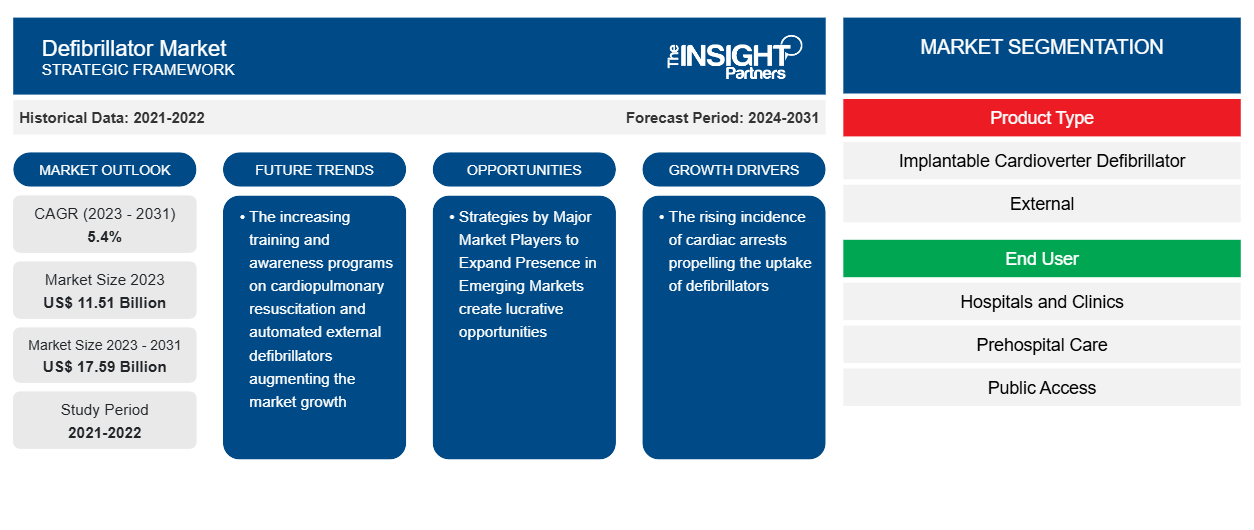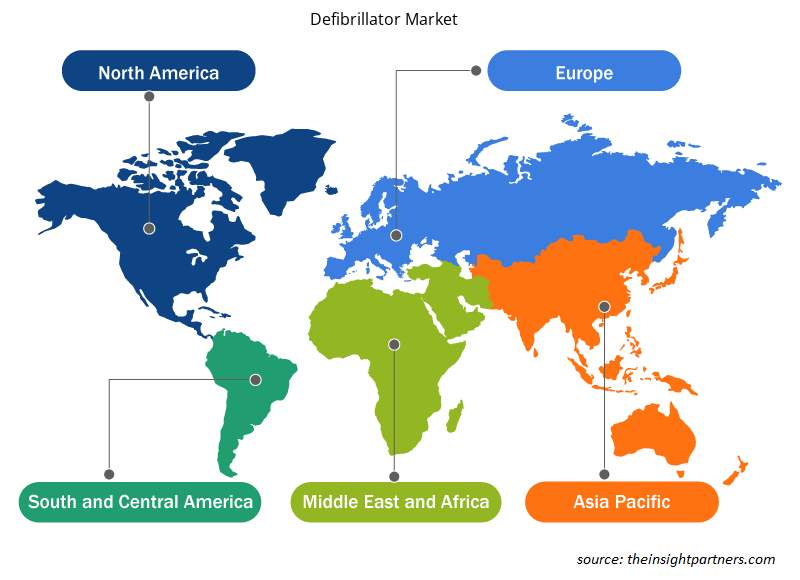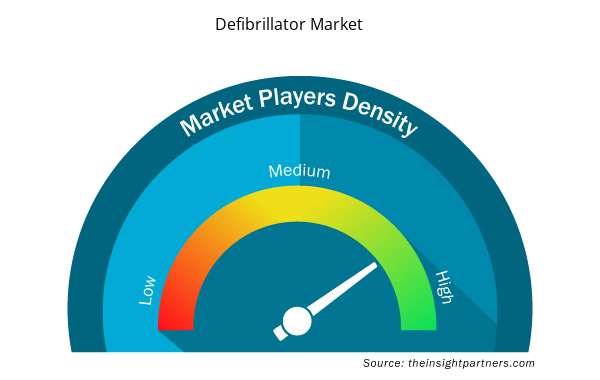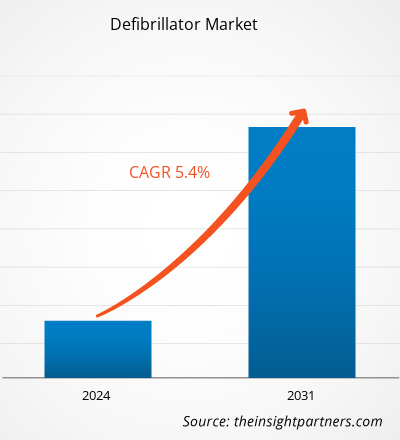The Defibrillator market size is projected to reach US$ 17.59 billion by 2031 from US$ 11.51 billion in 2023. The market is expected to register a CAGR of 5.4% during 2023–2031. Technological advancements and increased investments in defibrillators by private players are likely to remain key trends in the market.
Defibrillator Market Analysis
Defibrillators market is driven by the rising prevalence of cardiovascular disorders among large populations followed by the increasing training and awareness programs on cardiopulmonary resuscitation and automated external defibrillators. Additionally, various strategies adopted by market players for geographical expansion in emerging markets such as increasing investments, plant manufacturing in developing economies, and others are expected to create lucrative opportunities. Moreover, technological advancements and increased investments in defibrillators by private players are leading to significant future trends in the defibrillator market.
Defibrillator Market Overview
The rising prevalence of cardiovascular disorders among large populations followed by the increasing training and awareness programs on cardiopulmonary resuscitation and automated external defibrillators is driving the growth of the defibrillators market growth. North America is dominating the market owing to the increasing adoption of technological advancements and rising research and development activities are projected to accelerate the growth of the Defibrillator market. Moreover, the presence of large healthcare businesses and the growing usage of Defibrillator is propelling the market's expansion in this region. However, Asia Pacific is anticipated to register significant growth owing to the growing investments from international players in China and India, improving government support in countries, expanding the base of CRO services, and advancing healthcare infrastructure. Therefore, the region holds huge potential for the Defibrillator market players to grow during the forecast period.
Customize This Report To Suit Your Requirement
You will get customization on any report - free of charge - including parts of this report, or country-level analysis, Excel Data pack, as well as avail great offers and discounts for start-ups & universities
Defibrillator Market: Strategic Insights

- Get Top Key Market Trends of this report.This FREE sample will include data analysis, ranging from market trends to estimates and forecasts.
You will get customization on any report - free of charge - including parts of this report, or country-level analysis, Excel Data pack, as well as avail great offers and discounts for start-ups & universities
Defibrillator Market: Strategic Insights

- Get Top Key Market Trends of this report.This FREE sample will include data analysis, ranging from market trends to estimates and forecasts.
Defibrillator Market Drivers and Opportunities
Rising Training and Awareness Programs on Cardiopulmonary Resuscitation and Automated External Defibrillators to Favor Market
Online and offline training programs by organizations such as the WHO, US FDA, regional health centers, and local bodies have increased significantly. Various states in the US have enacted legislations to encourage the use of defibrillators and the availability of AEDs; they have also made provisions for educating and training people for the use and maintenance of AEDs. Additionally, several states have included the use of AEDs in the “good Samaritan” exemption from liability to promote its usage. For instance, in the UK, a training program was introduced by the Advanced Coronary Treatment (ACT) Foundation for secondary school students in association with British Columbia Emergency Health Services (BCEHS). Paramedic volunteers train teachers to educate students at BCEHS. In certain universities, BCEHS is planning to implement defibrillator training as a part of the physical education curriculum. The British Heart Foundation’s “Nation of Lifesavers – Call, Push, Rescue” is another example of a simplified training program that focuses on compression-only CPR and AED. The British Heart Foundation has also taken the lead in rallying medical professionals to support public education in the UK.
Strategies by Major Market Players to Expand Presence in Emerging Markets create lucrative opportunities
With rising cases of cardiovascular diseases in regions such as Asia-Pacific, and South and Central America, the defibrillator market players have started to or are expected to strategize their growth planning around these regions. Cardiovascular diseases have been among the leading causes of death in countries such as India, China, and Brazil. Companies such as Abbott, Medtronic, ZOLL, and Biotronik are expected to continue growing in these emerging markets through mergers, acquisitions, and strategic partnerships in the coming years. For instance, Medtronic invested over US$ 50 million in their manufacturing facilities in Puerto Rico. Over the years, establishment of sales subsidiaries in the Latin American and Asia-Pacific region by companies such as Nihon Kohden, Medtronic, and ZOLL shows the strategic positioning companies are looking to setup in the region. Biotronik, with its already established manufacturing plant in Singapore is looking to implement its research and development activities in the country to further strengthen its business capabilities. This shows ongoing and upcoming strategies by various market players to expand in emerging markets as well as strengthen its presence in other regions.
Defibrillator Market Report Segmentation Analysis
Key segments that contributed to the derivation of the Defibrillator market analysis are product type and end user.
- Based on product type, the Defibrillator market is bifurcated into implantable cardioverter defibrillator, and external defibrillator. The implantable cardioverter segment held a larger market share in 2023.
- By end user, the market is segmented into hospitals and clinics, prehospital care, public access, home care settings, and alternate care facilities. The hospitals and clinics segment held the largest share of the market in 2023.
Defibrillator Market Share Analysis by Geography
The geographic scope of the Defibrillator market report is mainly divided into five regions: North America, Asia Pacific, Europe, Middle East & Africa, and South & Central America.
North America has dominated the market owing to the increasing adoption of technological advancements and rising research and development activities are projected to accelerate the growth of the Defibrillator market. Moreover, the presence of large healthcare businesses and the growing usage of Defibrillator is propelling the market's expansion in this region. The US is projected to be the largest market for defibrillators, the market is attributed due to multiple factors such as increase in cardiovascular disease, rising awareness about the presence of innovative defibrillators, presence of leading pharmaceutical companies in this region and presence of well-developed healthcare infrastructure.. Moreover, in terms of technology, the nation is well ahead of other developed and emerging countries. Advances in technology have resulted in the development of various novel defibrillators and technologies that are used for their applications. Asia Pacific is anticipated to grow with the highest CAGR in the coming years.
Defibrillator Market Regional Insights
The regional trends and factors influencing the Defibrillator Market throughout the forecast period have been thoroughly explained by the analysts at Insight Partners. This section also discusses Defibrillator Market segments and geography across North America, Europe, Asia Pacific, Middle East and Africa, and South and Central America.

- Get the Regional Specific Data for Defibrillator Market
Defibrillator Market Report Scope
| Report Attribute | Details |
|---|---|
| Market size in 2023 | US$ 11.51 Billion |
| Market Size by 2031 | US$ 17.59 Billion |
| Global CAGR (2023 - 2031) | 5.4% |
| Historical Data | 2021-2022 |
| Forecast period | 2024-2031 |
| Segments Covered |
By Product Type
|
| Regions and Countries Covered | North America
|
| Market leaders and key company profiles |
Defibrillator Market Players Density: Understanding Its Impact on Business Dynamics
The Defibrillator Market is growing rapidly, driven by increasing end-user demand due to factors such as evolving consumer preferences, technological advancements, and greater awareness of the product's benefits. As demand rises, businesses are expanding their offerings, innovating to meet consumer needs, and capitalizing on emerging trends, which further fuels market growth.
Market players density refers to the distribution of firms or companies operating within a particular market or industry. It indicates how many competitors (market players) are present in a given market space relative to its size or total market value.
Major Companies operating in the Defibrillator Market are:
- Medtronic,
- Abbott,
- Boston Scientific Corp.,
- Zoll Medical Corp.,
- KONINKLIJKE PHILIPS N.V.,
- Biotronic, Inc.,
Disclaimer: The companies listed above are not ranked in any particular order.

- Get the Defibrillator Market top key players overview
Defibrillator Market News and Recent Developments
The Defibrillator market is evaluated by gathering qualitative and quantitative data post primary and secondary research, which includes important corporate publications, association data, and databases. A few of the developments in the Defibrillator market are listed below:
- WEL Medical launched DefibSafe 3 (DS3), a new generation of Automated External Defibrillator (AED) storage with an IP66 weather protection rating. The DS3 features a temperature management system that maintains the optimum performance of AEDs, managing its battery and pads effectively. This ensures the device remains at peak readiness, even if located within extreme outdoor environments. (Source: WEL Medical, Newsletter, April, 2024)
- Stryker launched two new products: LIFEPAK CR2 automated external defibrillator (AED) for cardiac care and Evacuation Chair for emergency patient evacuation. The LIFEPAK CR2 designed to empower rescuers in providing high-quality CPR and delivering instant shock during sudden cardiac arrest (SCA) emergencies (Source: Stryker, Newsletter, March 2024)
- Avive Solutions, Inc., received U.S. Food and Drug Administration (FDA) pre-market approval (PMA)—- the agency’s highest level of approval— for its Avive AED, a unique Automated External Defibrillator (AED). (Source: Avive Solutions, Inc., Company Website, January 2023)
Defibrillator Market Report Coverage and Deliverables
The “Defibrillator Market Size and Forecast (2021–2031)” report provides a detailed analysis of the market covering below areas:
- Defibrillator market size and forecast at global, regional, and country levels for all the key market segments covered under the scope
- Defibrillator market trends as well as market dynamics such as drivers, restraints, and key opportunities
- Detailed PEST/Porter’s Five Forces and SWOT analysis
- Defibrillator market analysis covering key market trends, global and regional framework, major players, regulations, and recent market developments
- Industry landscape and competition analysis covering market concentration, heat map analysis, prominent players, and recent developments for the Defibrillator market
- Detailed company profiles
- Historical Analysis (2 Years), Base Year, Forecast (7 Years) with CAGR
- PEST and SWOT Analysis
- Market Size Value / Volume - Global, Regional, Country
- Industry and Competitive Landscape
- Excel Dataset



Report Coverage
Revenue forecast, Company Analysis, Industry landscape, Growth factors, and Trends

Segment Covered
Product Type, End User, and Geography

Regional Scope
North America, Europe, Asia Pacific, Middle East & Africa, South & Central America

Country Scope
Argentina, Australia, Brazil, Canada, China, France, Germany, India, Italy, Japan, Mexico, Saudi Arabia, South Africa, South Korea, Spain, United Arab Emirates, United Kingdom, United States
Frequently Asked Questions
Which region dominated the Defibrillator market in 2023?
North America region dominated the Defibrillator market in 2023
What are the driving factors impacting the Defibrillator market?
The rising prevalence of cardiovascular diosrders among large population followed by the increasing training and awareness programs on cardiopulmonary resuscitation and automated external defibrillators are the driving factors impacting the Defibrillator market
What are the future trends of the Defibrillator market?
Technological advancements and increased investments in defibrillators by private players are the future trends of the Defibrillator market
Which are the leading players operating in the Defibrillator market?
The leading players operating in the Defibrillator market includes Medtronic, Abbott, Boston Scientific Corp., Zoll Medical Corp., KONINKLIJKE PHILIPS N.V., Biotronic, Inc., Progetti srl, Shenzhen Mindray Biomedical Electronics Co., Ltd., Nihon Kohden Corp. among others
What would be the estimated value of the Defibrillator market by 2031?
The estimated value of the Defibrillator market by 2031 is US$ 17.59 Bn
What is the expected CAGR of the Defibrillator market?
The expected CAGR of the Defibrillator market is 5.4%

 Get Free Sample For
Get Free Sample For